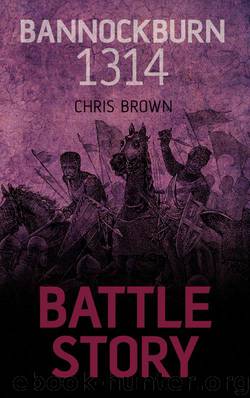Bannockburn 1314 by Chris Brown

Author:Chris Brown
Language: eng
Format: mobi, epub
ISBN: 9780752497860
Publisher: The History Press
Published: 2013-09-13T07:00:00+00:00
28. Articulated armour for the legs and arms was becoming increasingly common by 1314. This re-enactor is mounted on a ‘covered’ or ‘barded’ horse, though in the fourteenth century the barding would have consisted of several layers of cloth to reduce the effectiveness of arrows and edged weapons.
BEFORE THE BATTLE
Edward II’s Forces
Edward started the process of raising an army as early as October 1313 and was probably already planning an expedition before that. Doubtless he would have mounted a major response to Robert earlier had it not been for his internal political difficulties, his problems in France – not least the thorny business of negotiating the performance of the homage that he owed for Gascony – and the great burden of debt that he had inherited from his father. Similarly, Robert had started gathering his troops several weeks before the campaign and was able to have his forces in place before the English army mustered at Berwick and Wark.
The size of the Bannockburn armies has been the subject of much debate. Chronicle figures simply cannot be taken at face value. Barbour’s claim that there were 30,000 Scots and 100,000 English has been the basis for many estimates, though largely this would seem to be a matter of later writers assuming that he had inflated the armies by a factor of four, resulting in 7,500 Scots and 25,000 English. These figures are not altogether impossible, but in fact Barbour was not really offering figures to be taken literally. Many medieval authors used multiples of three to give an idea of scale in much the same way that we might use the term ‘thousands’ or even ‘millions’ when we just mean ‘a lot’. In medieval literature 300 can mean ‘a modest body’, 3,000 can be taken to indicate ‘a substantial body’ and 30,000 to mean ‘a very large body’. Barbour’s use of ‘30,000’ for the Scots and ‘100,000’ for the English is probably best interpreted as meaning that the Scottish army was very large and the English army was very much larger still. For Barbour, and his audience, the key information was that King Robert had assembled a massive force from across the country, demonstrating his political power. That said, Barbour did not shy away from the fact that there were still Scots in the English camp, telling us that Edward had the services of a great company of Scottish men-at-arms from Lothian. Although this is undoubtedly true, the claim does require a little examination. It is probably reasonable to assume that the company in question was drawn from more than just Lothian.
Download
This site does not store any files on its server. We only index and link to content provided by other sites. Please contact the content providers to delete copyright contents if any and email us, we'll remove relevant links or contents immediately.
| Africa | Americas |
| Arctic & Antarctica | Asia |
| Australia & Oceania | Europe |
| Middle East | Russia |
| United States | World |
| Ancient Civilizations | Military |
| Historical Study & Educational Resources |
The Radium Girls by Kate Moore(11644)
100 Deadly Skills by Clint Emerson(4708)
The Templars by Dan Jones(4562)
Rise and Kill First by Ronen Bergman(4557)
The Doomsday Machine by Daniel Ellsberg(4257)
The Rape of Nanking by Iris Chang(4029)
Killing England by Bill O'Reilly(3901)
Hitler in Los Angeles by Steven J. Ross(3809)
Stalin by Stephen Kotkin(3732)
12 Strong by Doug Stanton(3424)
Hitler's Monsters by Eric Kurlander(3177)
Blood and Sand by Alex Von Tunzelmann(3067)
Darkest Hour by Anthony McCarten(3019)
The Code Book by Simon Singh(2879)
The Art of War Visualized by Jessica Hagy(2846)
Hitler's Flying Saucers: A Guide to German Flying Discs of the Second World War by Stevens Henry(2633)
Babylon's Ark by Lawrence Anthony(2442)
The Second World Wars by Victor Davis Hanson(2428)
Tobruk by Peter Fitzsimons(2382)
